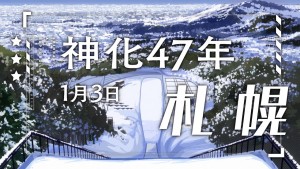 Long after far more popular and fleetingly-praised anime are forgotten, Concrete Revolutio is going to be remembered – I truly believe that. There’s just no end to the layers with this one – one gets peeled back and there’s another right beneath it. In true Bones fashion it’s a testing ground for myriad influences and ideas (the writer of this week’s episode is Nakashima Kazuki, the playwright who’s given anime Tengen Toppa Gurren Lagann and Oh! Edo Rocket). If you want formula you’re barking up the wrong tree – Concrete Revolutio blazes its own trail.
Long after far more popular and fleetingly-praised anime are forgotten, Concrete Revolutio is going to be remembered – I truly believe that. There’s just no end to the layers with this one – one gets peeled back and there’s another right beneath it. In true Bones fashion it’s a testing ground for myriad influences and ideas (the writer of this week’s episode is Nakashima Kazuki, the playwright who’s given anime Tengen Toppa Gurren Lagann and Oh! Edo Rocket). If you want formula you’re barking up the wrong tree – Concrete Revolutio blazes its own trail.
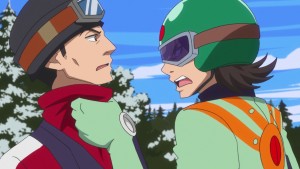 One word which I think describes this series especially well is “idiosyncratic”, in the best sense. The glee wth which is applies it’s differentness is almost perverse. I love the fact that Bones is never afraid to experiment – as with Space Dandy, Concrete Revolutio is steered by a prominent director who lets the bright lights in the industry take the wheel from week to week, steering the ship into interesting and unexpected ports of call. This show is uncompromisingly weird in a brilliant way that would make it memorable even if it weren’t telling an intellectually-dense and fascinating story – but the fact that it is makes Concrete Revolutio all the more precious.
One word which I think describes this series especially well is “idiosyncratic”, in the best sense. The glee wth which is applies it’s differentness is almost perverse. I love the fact that Bones is never afraid to experiment – as with Space Dandy, Concrete Revolutio is steered by a prominent director who lets the bright lights in the industry take the wheel from week to week, steering the ship into interesting and unexpected ports of call. This show is uncompromisingly weird in a brilliant way that would make it memorable even if it weren’t telling an intellectually-dense and fascinating story – but the fact that it is makes Concrete Revolutio all the more precious.
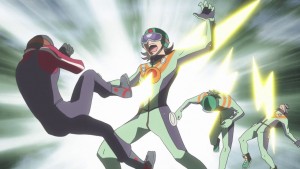 It’s been clear for a while now that the timeframe of Concrete Revolutio is a direct analog for the late 60’s and early 70’s in Japan, but this week’s episode pretty much cements it – to the point where we can say that at least loosely, “Year 47 of the Shinka Era” is 1972. That’s because 1972 was the year of the Sapporo Olympics, and the “GP Festival” was an obvious allusion to that event. That was the year three Japanese men made history by sweeping the medals on the normal hill event (no Japanese had ever won a medal in the sport before then; interestingly, every medal awarded in ski jumping at Sapporo went to a nation that had never won one). It was also the year when controversy swirled over the participation of “professionals” in what was supposed to be an amateur competition, and over the definition of “amateur” itself.
It’s been clear for a while now that the timeframe of Concrete Revolutio is a direct analog for the late 60’s and early 70’s in Japan, but this week’s episode pretty much cements it – to the point where we can say that at least loosely, “Year 47 of the Shinka Era” is 1972. That’s because 1972 was the year of the Sapporo Olympics, and the “GP Festival” was an obvious allusion to that event. That was the year three Japanese men made history by sweeping the medals on the normal hill event (no Japanese had ever won a medal in the sport before then; interestingly, every medal awarded in ski jumping at Sapporo went to a nation that had never won one). It was also the year when controversy swirled over the participation of “professionals” in what was supposed to be an amateur competition, and over the definition of “amateur” itself.
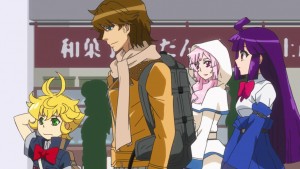 As it was in most places, this era was a contentious and difficult one in Japan – starting with an explosion of idealism and creativity, quickly descending into violent confrontation and ending in disillusionment and malaise. I really wish I knew more about this period in Japanese history because I’m fully aware that so much of Concrete Revolutio is going over my head, but even cursory knowledge is enough to understand the gist of what Aikawa and Mizushima are trying to do here. In many respects Nakashima-sensei’s episode feels like a side story (albeit a brilliant one) but it’s connected in a tonal and philosophical sense. It acts like a microcosm of all of this series’ ideas and messages in 22 minutes.
As it was in most places, this era was a contentious and difficult one in Japan – starting with an explosion of idealism and creativity, quickly descending into violent confrontation and ending in disillusionment and malaise. I really wish I knew more about this period in Japanese history because I’m fully aware that so much of Concrete Revolutio is going over my head, but even cursory knowledge is enough to understand the gist of what Aikawa and Mizushima are trying to do here. In many respects Nakashima-sensei’s episode feels like a side story (albeit a brilliant one) but it’s connected in a tonal and philosophical sense. It acts like a microcosm of all of this series’ ideas and messages in 22 minutes.
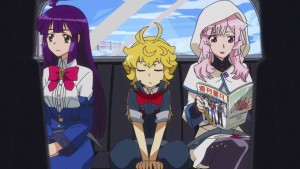 One wonders if Nakashima (who was 13 when the Sapporo Olympics took place) is making a comment about the use of PEDs in the story of the “Three Birdmen“, or just a more general musing on the degradation of the Olympic ideal as money and politics more and more came to dominate amateur sports. There’s certainly a strong endorsement of the competitive ideal here in the person of Amato Kouichi, the ski jumper (a Sapporo boy to boot) who refuses to have an operation to give his muscles and bones superhuman strength. And a strong environmental and cultural message too – countless thousands of Shrines have been plowed under in the name of progress, something the innately Shinto Japanese have never gotten totally comfortable with.
One wonders if Nakashima (who was 13 when the Sapporo Olympics took place) is making a comment about the use of PEDs in the story of the “Three Birdmen“, or just a more general musing on the degradation of the Olympic ideal as money and politics more and more came to dominate amateur sports. There’s certainly a strong endorsement of the competitive ideal here in the person of Amato Kouichi, the ski jumper (a Sapporo boy to boot) who refuses to have an operation to give his muscles and bones superhuman strength. And a strong environmental and cultural message too – countless thousands of Shrines have been plowed under in the name of progress, something the innately Shinto Japanese have never gotten totally comfortable with.
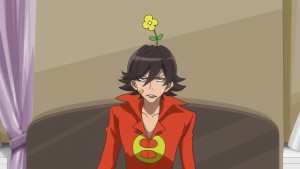 What strikes me about the GP scenario is this: isn’t any competition open to surgically-enhanced quasi-superhumans meaningless? Indeed, while Amato – who refused the operation – is the undisputed hero of the episode, it’s the Birdmen who win the medals at the end. What’s the point? There are important contextual elements here for the series as a whole, no doubt – it cuts to the very question of what defines a superhuman. When the local forest Kami Pirikappi, whose domain has been flattened for the ski jump facility, takes action by zapping the locals with lightning bolts and causing flowers to grow out of their heads, the visiting Superhuman Bureau reps are immune. But not the Birdmen – like the “normal” humans, they’re impacted.
What strikes me about the GP scenario is this: isn’t any competition open to surgically-enhanced quasi-superhumans meaningless? Indeed, while Amato – who refused the operation – is the undisputed hero of the episode, it’s the Birdmen who win the medals at the end. What’s the point? There are important contextual elements here for the series as a whole, no doubt – it cuts to the very question of what defines a superhuman. When the local forest Kami Pirikappi, whose domain has been flattened for the ski jump facility, takes action by zapping the locals with lightning bolts and causing flowers to grow out of their heads, the visiting Superhuman Bureau reps are immune. But not the Birdmen – like the “normal” humans, they’re impacted.
 It’s Amato who gets blamed for all this – certainly by two of the three Birdmen and even by Jirou, who’s come to town assuming Amato did it with a secret superpower and aiming to get to him before the Bureau does. But the truth becomes clear when all of the humans with flowers on their head turn first into zombies, and then into a human forest. There’s something genuinely and honestly beautiful in the denouement of this story. Amato, who as a boy was chosen to complete a ritual of firing an arrow into a target at the local festival in order to ensure a good harvest, is given a chance by Pirikiappi to hit a target again – effectively becoming a human arrow and landing in a bullseye amongst the human trees. Amato soars above all the corruption and politics and greed and succeeds without any help – no surgery, no aid from the Bureau or Jirou (who stops the others from helping), relying wholly on his own strength and skill. It’s a rare idealistic moment in a story focused like a laser on the loss of idealism.
It’s Amato who gets blamed for all this – certainly by two of the three Birdmen and even by Jirou, who’s come to town assuming Amato did it with a secret superpower and aiming to get to him before the Bureau does. But the truth becomes clear when all of the humans with flowers on their head turn first into zombies, and then into a human forest. There’s something genuinely and honestly beautiful in the denouement of this story. Amato, who as a boy was chosen to complete a ritual of firing an arrow into a target at the local festival in order to ensure a good harvest, is given a chance by Pirikiappi to hit a target again – effectively becoming a human arrow and landing in a bullseye amongst the human trees. Amato soars above all the corruption and politics and greed and succeeds without any help – no surgery, no aid from the Bureau or Jirou (who stops the others from helping), relying wholly on his own strength and skill. It’s a rare idealistic moment in a story focused like a laser on the loss of idealism.
P.S. Make sure you stay tuned for the preview. It’s my favorite of the season so far.



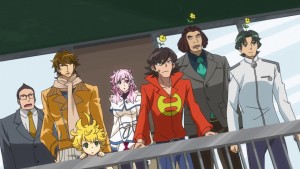
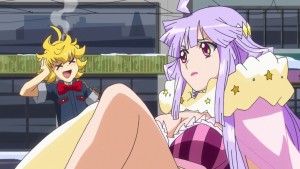
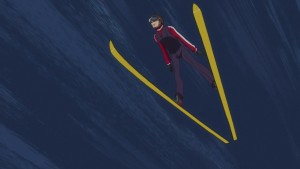
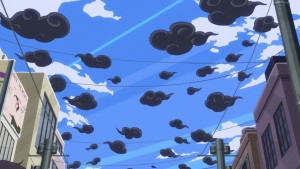
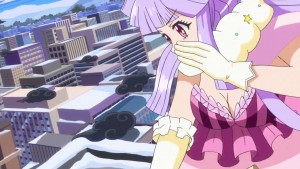
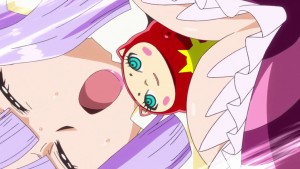
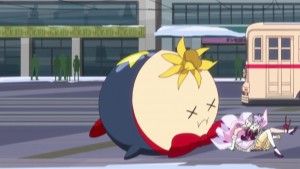
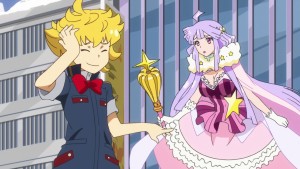
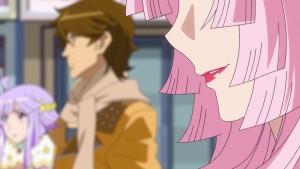
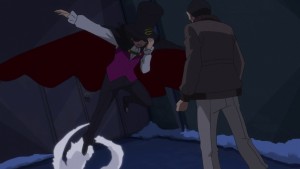
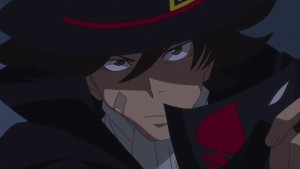

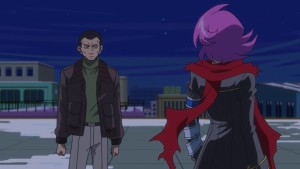
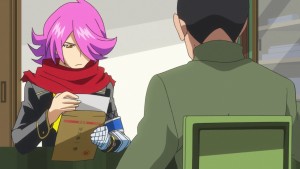
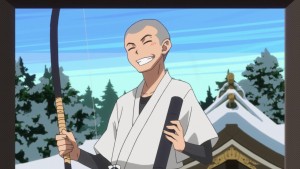
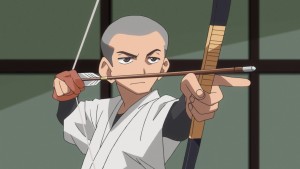
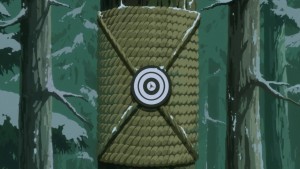
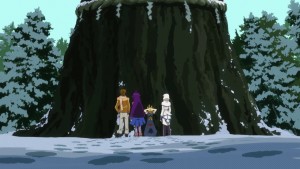
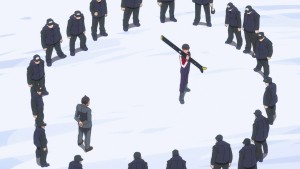
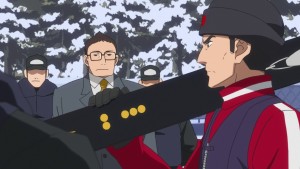
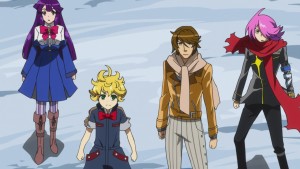


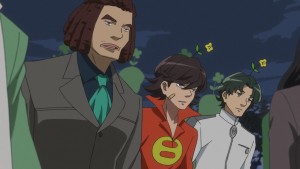

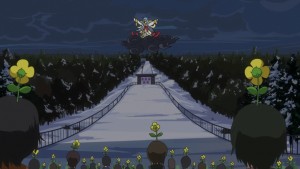
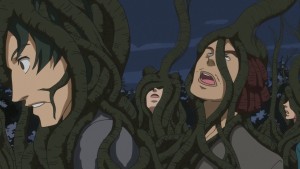
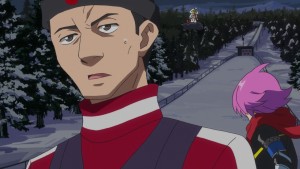
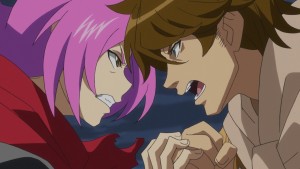


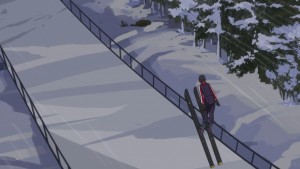
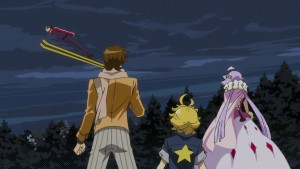
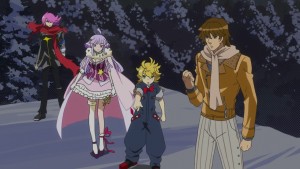
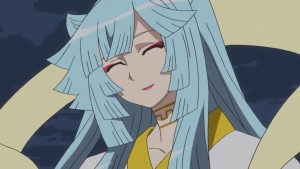
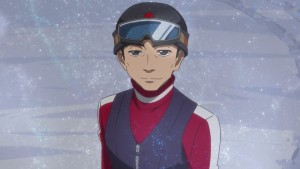
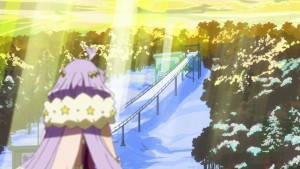
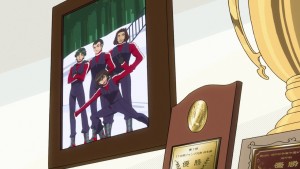
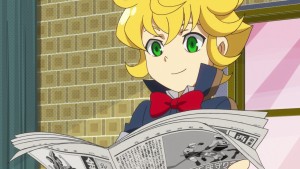
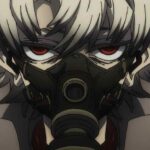
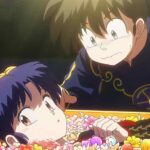
Earthling Zing
April 23, 2016 at 9:06 pmGreat informative readup, that’s especially helpful in this show where there’s a ton of references I don’t get. This episode reminded me a lot of Space Dandy too, weird stuff happening which accumulates with a nice moral to tie it off.
Faolin Eye
April 24, 2016 at 6:45 amAlthough it wasn’t the most impressive episode in terms of visual flare, the multi-layeredness of the story still makes this show one of the best of this season. And I am also looking forward to the next ep, it seems that Kikko will steal the limelight this time, so it should be interesting. (The backstories of Kikko and Emi haven’t been revealed in detail, so maybe we’ll get an advancement on that front too)